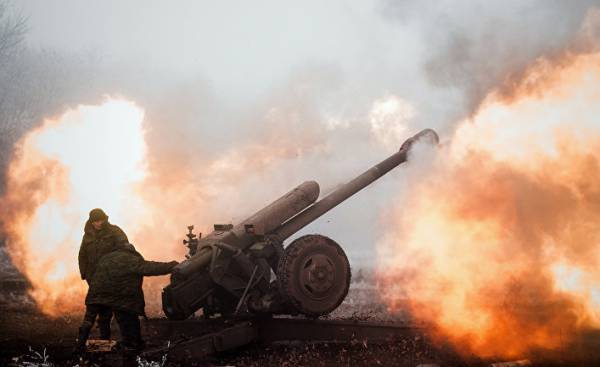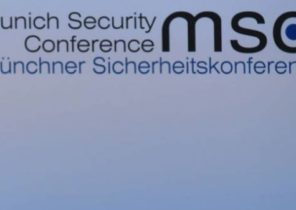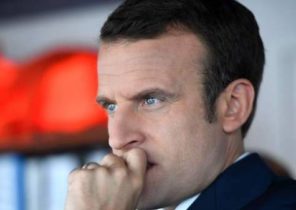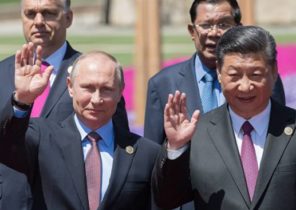
The maintenance of the armed conflict of low and medium intensity in the Donbass is part of Russia’s long-term strategy of pressure on Ukraine. The persistence of conflict creates opportunities for economic and political vulnerability of Ukraine, which could open up for Russia a window of opportunity to impose a “peace at any price”.
The conflict in the East of Ukraine called Donbass a paradox. Despite the Minsk agreement, providing for, among other things, an immediate ceasefire, withdrawal of heavy weapons and the monitoring of the demarcation line of the OSCE, the fighting in Eastern Ukraine continues with frequent bursts of intensity.
The conduct of hostilities, including low-intensity conflicts, costly not only in financial, but also human dimension, so such a confrontation, as a rule, at the first opportunity goes to the stage of frozen conflict, as it happened in Transnistria, Abkhazia and Nagorno-Karabakh. An armed confrontation in the Donbas is a strategic instrument of pressure on Ukraine.
Smouldering armed conflict in the Donbass largely creates a stable atmosphere of instability and unpredictability in the Ukraine. During its flow, the conflict had largely routingservice, but a request for its resolution in Ukraine is not reduced exactly three quarters of the population of Ukraine (75%) believe “the settlement of the situation in the Donbass and achieving peace”, the highest priority for the Ukrainian authorities. Obviously, further delaying the resolution of the hot phase of the conflict in the Donbas is the source of more tension in the Ukrainian society, gradually eroding the confidence in the current authorities in Kiev.
In the spring of 2017 opportunities for the implementation of the Minsk agreements was even more limited. Soon after the nationalization of the separatists of Ukrainian jurisdiction, is located on uncontrollable Kiev territories of Donbass, Ukraine introduced in response to the mode of transport blockade in relation to these territories. Thus was terminated the transit of goods by road and rail routes across the line of demarcation with the exception of goods of a humanitarian nature. The gap of economic ties in the light launched the transport blockade has deepened the contradictions between Ukraine and Russia-controlled separatists in the Donbas.
The prospect of progress in the implementation of the Minsk agreements in such conditions becomes even more vague. Request conflict resolution from the public and possible change of political elites in view of the presidential and parliamentary elections in Ukraine in 2019 can undermine the stability of the current position of Kiev and to open the way for “painful compromises”.
An important negative consequence of the armed conflict in the East of Ukraine is limiting the ability to establish effective two-way dialogue between residents of a now uncontrolled territories of Donbass and rest of Ukraine. The ongoing clashes and mutual attacks are not conducive to establishing trust and cooperation between people on both sides of the line of contact. This line over of the conflict can gradually be transformed for residents of Donbass in the mental dividing line that separates “own” from “strangers” or even “our” “enemies.”
It is worth noting that the lingering conflict undermines the investment attractiveness of Ukraine. Despite the localized nature of the conflict — the limited scale of the fighting taking place only in certain districts of Donetsk and Lugansk regions of Ukraine — in the perception of the uninitiated layman abroad in Ukraine there is a real war. Therefore, Ukraine is unlikely to be sufficiently attractive for inflows required to restore the economic potential of the country’s foreign investment, at least as long as the conflict in Donbass remains in his “hot” phase.
Studies of the Berlin Centre for East European and international studies (ZoiS) still leave some room for optimism. According to their results, the ongoing hostilities in the East of Ukraine have not yet led to the emergence of “a distinct ethnic and political boundaries” between residents of two parts of Donbass divided by war. This is facilitated by regular contact and crossing control points of entry and exit (KPVV) in the Donbas daily by thousands of residents of the region.
However, accumulated over time, public tension due to the protracted war, can even more strengthen in the Ukrainian society the demand for “peace at any price”. The latest public opinion surveys in 2016 already confirmed the significance of such a request in Ukraine for almost a quarter of respondents at that time, Ukrainians (23%) expressed support for any compromise for the sake of peace in the Donbass. It cannot be excluded that the increase in such public demand against the background of continuing hostilities will undermine the already shaky confidence in the current authorities in Kiev and give ground to the opponents to put the current government as unable to solve the most acute problem in Ukraine.
The Ukrainian authorities have provided for themselves and their Western partners principled position that progress on the political track of the Minsk agreements, which includes the law on elections and the special status for separate areas of Donbass, is possible only after achieving steady progress in terms of ensuring security within the framework of a comprehensive ceasefire, withdrawal of all heavy weapons and provide verification of the cease-fire.
The Russian party effectively controlled by the separatists in the Donbass, probably can go to a conditional truce only if Ukraine first unilaterally fulfill their demands Amnesty for all combatants, the law on local elections in certain districts of Donetsk and Lugansk regions and the approval of the special status now uncontrolled territories in Donbas at the level of the Constitution of Ukraine. Such unilateral political concessions are totally unacceptable from the point of view of official Kiev. After all, their performance in absolute violation of the ceasefire, the absence of basic components of security in the region and uncontrolled part of the Russian-Ukrainian border would be, in fact, the legalization of the existing separatist regimes “DNR-LNR”, and not the process transparent embedding data areas in the legal field of Ukraine.
In the medium term describes the change in public sentiment could find a natural expression in the form of coming to power in Ukraine is more loyal and compliant to Russian interests political forces. “Peace at any price” can be too costly for Ukraine.







